Table of Contents
SaaS application adoption is growing more and more every year. So much so that the days of on-premise software may become a thing of the past. The worldwide use of SaaS increased by more than 10-fold since 2015.
With this proliferation of SaaS applications came a unique challenge for CIOs and CFOs. That challenge is deciding whether certain apps are worth the investment.
With so many SaaS applications out there, it’s important to remember not all of them are created equal. Neither are they wholly unique, or worthy of adoption alongside other applications that do the same tasks in equal or greater capacity. Adopting the wrong tools in your organization’s SaaS stack can eat up spending without providing meaningful returns.
Unfortunately, many organizations find themselves wasting money on SaaS that isn’t working for them.
That’s why it’s important for CIOs and CFOs to root out bad apps to maximize their SaaS investments.
What Are Bad Apps?
Bad apps can still be good tools. They’re just not the right tools for you. Choosing the wrong applications is a wasted investment. So, how do you know they’re the wrong tools? What makes a tool a bad app?
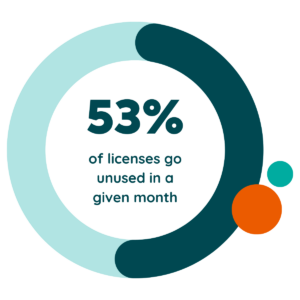 To answer that, you have to look at the data. You can identify a bad app when you see:
To answer that, you have to look at the data. You can identify a bad app when you see:
Unused Licenses
Zylo’s data has found that 53% of SaaS licenses in a typical company go unused every month. That means, on average, companies waste $21M on unused SaaS licenses. Bad applications often go unused or underutilized, causing a financial strain on your company with low or even negative ROI. Optimizing your licenses for the apps you do use is key in mitigating this cost.
Low Adoption
Perhaps an application has too niche of a function, or it’s simply not working for its designed task. Either way, low adoption rates for SaaS applications is a telltale sign of a bad app.
Redundant Applications
Let’s be honest. Even with the diversity of SaaS applications allowing overlapping functions to work differently for various LOBs, no organization needs 12 apps with the same purpose. In our research, among the top three most redundant application functions (online training classes, project management, and team collaboration) there’s an average of $477K to $2.8M in potential cost savings.
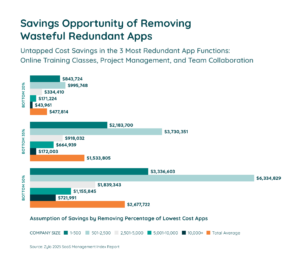
At the end of the day, these are the applications costing more than what’s necessary. These applications prevent CFOs and CIOs from maximizing their return on investment and SaaS portfolio efficiency.
How to Address Bad Apps
With the cost of bad apps weighing on the budget, what should an enterprise do to combat them? There is no one-and-done approach. The process of preventing bad apps in an enterprise’s SaaS portfolio is an ongoing program with a system of management that monitors what enters and leaves an organization’s SaaS environment.
A successful SaaS Management program can take many forms depending on the enterprise that builds it. However, some key qualities must be present.
Collaboration
When it comes to combating bad applications through SaaS Management, you need to establish communication throughout the entire organization. Proactively collaborating with stakeholders to determine what they need and what they’re currently using enables you to align your SaaS portfolio with business goals.
Once you understand your business needs, you’re able to ensure you’re only purchasing and renewing the right tools.
Empower Employees
SaaS management isn’t about taking control out of the hands of your employees. It’s about working with them to ensure compliance while still empowering them to get the tools they need.
This is freedom within a framework governance. As an approach to SaaS Management, this framework puts you in control of what SaaS your employees use while still providing them the flexibility they’ve grown accustomed to.
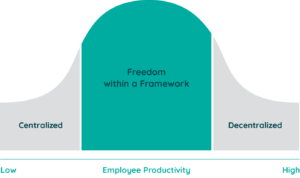
Categorizing your applications alongside established guidelines and reviews allows you to provide a catalog of compliant-ready applications for your employees to choose from.
Giving your employees the power and flexibility to choose their own tools often results in more productive employees. More productive employees mean a more productive business, and that means better ROI from your SaaS portfolio.
Evolving Your SaaS Governance Framework for the Digital Workplace
Learn MoreHave a Long-term Strategy
As we discussed, SaaS management is more than a project. It’s a program to weave into the very architecture of your enterprise. It isn’t a quick fix. Rather, integrating a system of SaaS Governance allows your organization to look beyond the needs of today, and choose the applications that serve your business’s longevity.
But how is this done?
Understand Your Environment
It all begins with visibility. With so many SaaS buyers distributed across the modern enterprise, from LOBs to individual employees expensing SaaS, it’s hard to get a grasp of what it’s in the entire SaaS portfolio. In fact, 1 in 15 (6.6%) employees will expense SaaS at some point. However, it is a necessity for any effective SaaS management program to achieve full visibility. After all, how can you manage what you cannot see?
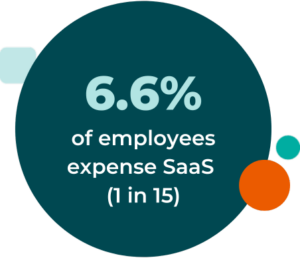 With visibility established, you can begin to identify and monitor your SaaS inventory. From there you can build a process for review and optimization. Not only does it enable you to manage application adoption and intake, but it also continuously reviews the state of your SaaS portfolio.
With visibility established, you can begin to identify and monitor your SaaS inventory. From there you can build a process for review and optimization. Not only does it enable you to manage application adoption and intake, but it also continuously reviews the state of your SaaS portfolio.
The SaaS Discovery process allows you to see:
- The apps you have
- How much you’re spending
- How apps are used
- Where your applications overlap and create redundancies
- Where you have duplicate purchases or contracts for the same app
How the Zylo Discovery Engine Powers the Most Comprehensive SaaS Management Platform
Learn MoreUse Data to Take Action
This in turn brings us to optimization and rationalization. By measuring the usage and costs of your now visible applications, you can identify those bad applications that just aren’t working for you. Look for low adoption rates, duplicate licenses, and underutilized applications to mothball or consolidate.
Zylo recommends a utilization rate of 90% or higher. If your applications fall short of that, it’s time to take a deeper look. The data will allow you to look into usage, and where there are opportunities for quick savings. You’ll find that active users typically log into an application within the last 30-60 days. From there you can measure how many people on a team are using the app regularly or at all.
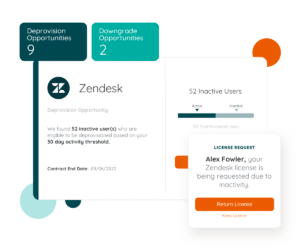 For example, if while examining this data you find that half of a team is utilizing an application, you may have found a good opportunity to scale back on licenses.
For example, if while examining this data you find that half of a team is utilizing an application, you may have found a good opportunity to scale back on licenses.
For the most meaningful impact, start with your heavy hitters, your highest-cost applications.
The same can be applied to duplicative tools. If data show your enterprise is using 14 project management tools, you may have found an opportunity to rationalize your portfolio down into the single digits. As a result, you maintain the same utility while reducing SaaS spending.
Leveraging usage and spend data allows you to paint a full picture of your SaaS portfolio. From there, utilize feedback from users to decide which apps you should keep or drop from your SaaS stack.
Use a SaaS Spend Management Tool
This process is admittedly no easy task when approached through manual methods. The dynamic nature of the SaaS environment is difficult to track manually. The average company has 275 SaaS applications, and this number is by no means static. Applications constantly leave and enter the SaaS environment. As a result, spreadsheets and other manual methods quickly become outdated, requiring a huge time sink to update.
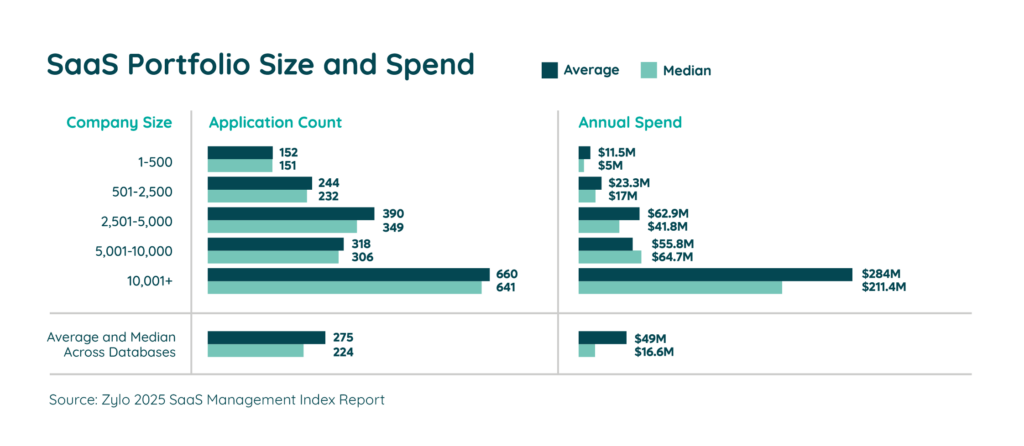
That’s why you need a dedicated SaaS management tool.
Utilizing a SaaS spending management tool such as Zylo allows you to easily make data-driven decisions to reduce waste and spending in your SaaS portfolio.
What’s more, Zylo allows you to eliminate bad applications from your portfolio. Zylo’s platform empowers you to :
- Gain Complete SaaS Visibility – Zylo utilizes an AI-powered matching model to automatically find and classify all of your SaaS applications, even Shadow IT which often flies under the radar and causes unseen costs and risks.
- Optimize SaaS Licenses – Personalized and prioritized views of your SaaS license data with Zylo Insights give you easy-to-understand recommendations in order of highest impact. Get a deeper understanding of your usage to discover bad applications with Zylo.
- Rationalize Your Saas Portfolio – Understanding the current state of your SaaS portfolio with Zylo Insights allows you to quickly make rationalization and rightsizing decisions.
Check out our ebook for a practical guide to SaaS rationalization, rightsizing, and renewals for more information on how you can eliminate bad applications from your SaaS portfolio today.

